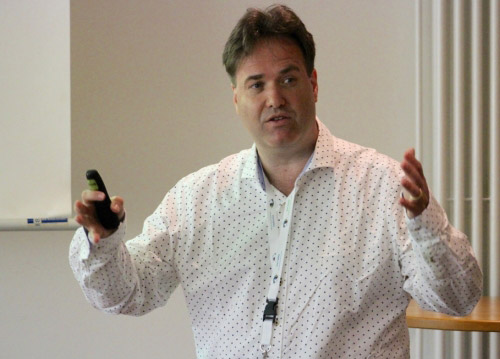







It's time for an overhaul, from sales and marketing to internal systems to end user relations, an Osram specialist says.
HAMBURG – As lighting vendors try to shift from the century-honed practice of selling light bulbs to selling services based on Internet of Things (IoT) connectivity, they are looking at nothing less than overhauling just about everything in their corporate structure and value chain by implementing radical new business models.
The reshaping spans across a wide range of practices, such as targeting a potential customer's CEO rather than the facilities manager; altering salesforce incentives and compensations; replacing internal computer systems; and much more.
So spelled out a change specialist from lighting giant Osram, in a presentation at the Smart Lighting Conference 2017 here yesterday.
“Developing a service business model is basically redesigning your business,” said Stijn Brocker, head of connected lighting for Osram. “If you change your business model, you're basically reinventing your company.”

After listening to Osram's Stijn Brocker, you might get the sense that the technology changes are easy compared to the business process transformation. (Photo credit: Mark Halper.)
Internet of Things schemes equip luminaires with sensors and communications chips. They connect to data networks, and end users deploy them for everything from improved lighting controls to gathering information about what's happening on their premises.
Brocker noted that IoT lighting is a perfect match for a service model. Not only does a service contract typically spare end users the upfront cost of buying new lights and controls, but it also relieves them of trying to figure out complex technology choices in a world where the technology is changing rapidly and is full of confusing choices.
But for an industry like lighting — steeped in a product mindset — implementing a service approach is daunting.
“What a lot of people don't understand is developing a new business is very complex,” Br?cker said. “If you're changing after 100 years in the lighting industry to a new business model, you basically need to change everything.”
One of the biggest changes: Whereas lighting vendors are accustomed to selling to facilities managers, they must now aim higher in an organization, all the way up to the chief financial officer and chief executive officer. One practical reason is while service contracts can run for 5 or 10 years, facilities managers are often forbidden to sign a contract that lasts more than a year or so, Brocker noted. From a broader perspective, IoT lighting's benefits can potentially appeal to the strategic vision that preoccupies CEOs more than facilities managers and other potential entry points at a company.
At the same time, sales and marketing must continue to appeal to the facilities manager and others, all of whom can be involved in the final purchasing decision.
“You need to play chess,” said Brocker. “You need to know all the pieces on the board. You need to interest the facilities manager with the proposition of better light or low maintenance. The energy manager is involved. He wants energy efficiency. He's not interested in better light. He's only interested in cutting energy. The purchasing manager at some point gets involved. He's basically only interested in price.
“The chief financial officer needs a business case. And if you talk to the chief executive officer, it's a little bit of a business case, but this is typically a strategic-thinking person. The chief executive officer wants to bring the company forward. So you need to sell him a vision and how your service model fits his vision.”
That's all only part of the challenge. Lighting companies must also figure out how to compensate sales staff who have long sold based on hardware commissions, which no longer apply in a service world. Similarly, the process of selling to wholesalers who have worked with electricians for final installations is under threat. That in turn presses lighting vendors to figure out how and whether to rework longstanding relationships with distribution partners.
Combine all of that with a remake of other processes both inside and outside the company, and another major change is in order — to the enterprise resource planning programs from companies such as Oracle, SAP, and Salesforce.com.
“Oh, man, try to change an ERP system. That's why I have some gray hair,” said Br?cker, who prior to joining Osram last September headed a services group at Austrian lighting vendor Zumtobel (and who doesn't really have a lot of gray hair).
Brocker also cautioned lighting vendors to avoid using leasing companies as the contractual link to a customer, which often happens in rudimentary, pre-IoT lighting-as-a-service deals. Leasing contracts can leave a customer as the owner of outdated equipment once the contract expires. Not only that but customers can feel duped.
“They say, ‘If I want a leasing contract, I'll go to my bank,’” noted Br?cker. “So if you want to sell services, you have to be willing to make a service contract directly with the customer.”
After 100 years of practicing a straightforward sales approach, the shift to a new service-oriented business model might be just as profound a change as the shift to LED technology itself has been.
Copyright 2006-2025 Shanghai Sinoexpo Informa Markets International Exhibition Co., Ltd. All rights reserved